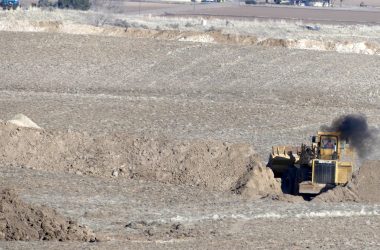Malheur County Development Corp.’s plan for the Nyssa reload center needs to be revised to overcome a “misalignment of agendas,” “lack of clarity” and an “incomplete” design for what has been promoted as an economic savior for Malheur County, according to a new independent report.
The public development company, created by Malheur County, has operated for more than five years under a plan for the Treasure Valley Reload Center that cost more than $600,000 to develop.
An outside consultant now suggests the proposed rail depot was put in the wrong place, rail spurs costing millions need to be changed and a more sharply focused business operation planned.
Axiom Project Development Services of Boise was hired by the development company to help jump start the stalled project. The company’s first report, done at a cost to the county of $9,875, proposes an ambitious effort to devise a new business plan, design, budget and funding plan in the next 30 days. That work could cost up to $57,750, Axiom estimated.
The board of the development company has approved the work.
“The team needs to be rebuilt. Design, construction, and operations expertise must be brought on board.”
–Consultant’s report
Shawna Peterson, company executive director, on Saturday canceled a board meeting scheduled for Tuesday, Jan. 23, to “be replaced with small group meetings.”
The urgency to act is prompted by a looming deadline to deliver to the state a plan to revitalize a project that has consumed more than $30 million in public funds, remains far from finished, and will require millions more to finish.
The Oregon Department of Transportation wants information to decide whether to keep pouring state money into the project – or end state support.
Axiom’s Jan. 10 report outlined what needs to be done to give the state reason to stay at the table. But the report also considered why the project stalled in the first place.
The results anticipated by a plan unveiled in 2018 “have not been achieved due to misalignment of agendas, lack of clarity on business plan directives, and challenges like site conditions and inflation.”
The nine-page report included a construction site map and questions about 10 design decisions, ranging from why a road was built at the construction site to whether engineers accounted for privately-owned land in the center of the project.
“The design is not in alignment with the business plan,” they wrote. “The design is incomplete.”
READ IT: Axiom’s report
The report didn’t detail the design flaw or what was incomplete. Anderson Perry & Associates, a LaGrande engineering firm, was the lead engineer on the project until early this year. The company was paid more than $1.8 million for design work and supervision of construction.
Company officials didn’t respond to requests for comment. Axiom noted that its report is based in part on discussions with RailPros, the rail engineering firm that worked on the Nyssa project.
Axiom noted there was a “lack of clarity” in the development company’s business plan.
“There is a need to better define, diversify and document the business plan and its objectives,” the report said. “This plan needs to provide clarity on fundamental factors.”
It noted that “components” of the original plan are “viable.”
The prime goal of the reload center has been to cut shipping costs for area onion producers, loading the produce on freight cars for more efficient movement to markets in the East.
Axiom officials said in response to questions that there is “ambiguity” about that concept and project leaders should confirm volumes, pricing and logistics.
The development company now is examining other ways to use the rail center, including as a freight destination for goods destined for the Treasure Valley. The original plan didn’t anticipate any train shipments to Nyssa.
Axiom recommended the project team consider shipping other “agricultural products, frozen goods, shipping containers, mined commodities.”
The consultants also noted a change in management, apparently a veiled reference to the departure of Greg Smith, a Heppner contractor in charge of the project until he abruptly quit last year.
Changes in “key positions” have “increased transparency, efficiency, and confidence,” the report said.
Peterson, an Ontario attorney, was hired last year as executive director of the development company. She triggered a pause in construction, terminated the Anderson Perry contract, and proposed a fresh look at the project that is now underway.
For the moment, the development company has no construction company, no engineering firm and no operator on board.
“The team needs to be rebuilt,” Axiom said. “Design, construction, and operations expertise must be brought on board.”
The consultants also said oversight of the project needs to be improved. Smith and his team often made crucial decisions without board consideration, such as scrapping one of four rail spurs planned for the Nyssa project. That decision had to be reversed months later when the board learned that Union Pacific Railroad would require all four spurs before serving Nyssa.
Axiom suggested refinements in how the development company operates to “ensure leadership is fully informed, able to make informed decisions, document direction and approvals, and facilitate an efficient decision-making process.”
Axiom also recommended stronger “communication protocols” to track progress if the project moves ahead.
“This will achieve trust and clarity,” the report said.
But first the development company has to win the state’s approval to keep going.
Axiom projected completion by Feb. 12 of an updated market study, a design review, an industrial master plan, a budget and funding strategies.
Peterson has been under a February deadline to provide information to be considered by Transportation Department officials.
The state last August froze funding, telling the development company that it had to resolve two “major hurdles.” The state identified those as the need for more than $5 million to finish construction under the original plan and to find a new company to operate the rail depot.
“We will need to see a clear ability to finish constructing the project and a proven facility operator locked in through an operator agreement to consider this a viable project,” the agency wrote.
The state said at the time that no more state money should be spent, including an additional $8 million awarded by legislators.
The Transportation Department, however, has proven lenient, subsequently disbursing more money to the development company despite the freeze.
Erik Havig, the statewide policy and planning manager for the Transportation Department, said the state agreed to release additional funds for work “performed in good faith.” In a later email, Friday, that work occurred prior to the August letter, even if the invoices came in after the letter was sent.
He said the decision may go to the Oregon Transportation Commission or the agency’s director, but they have yet to have those conversations and that’s just his “gut feeling.”
PREVIOUS COVERAGE:
State halts funding for Treasure Valley Reload Center, imposes conditions
State will not enforce deadlines on rail reload project, waiting for new plan
News tip? Send your information to [email protected].
HOW TO SUBSCRIBE – The Malheur Enterprise delivers quality local journalism – fair and accurate. You can read it any hour, any day with a digital subscription. Read it on your phone, your Tablet, your home computer. Click subscribe – $7.50 a month.




